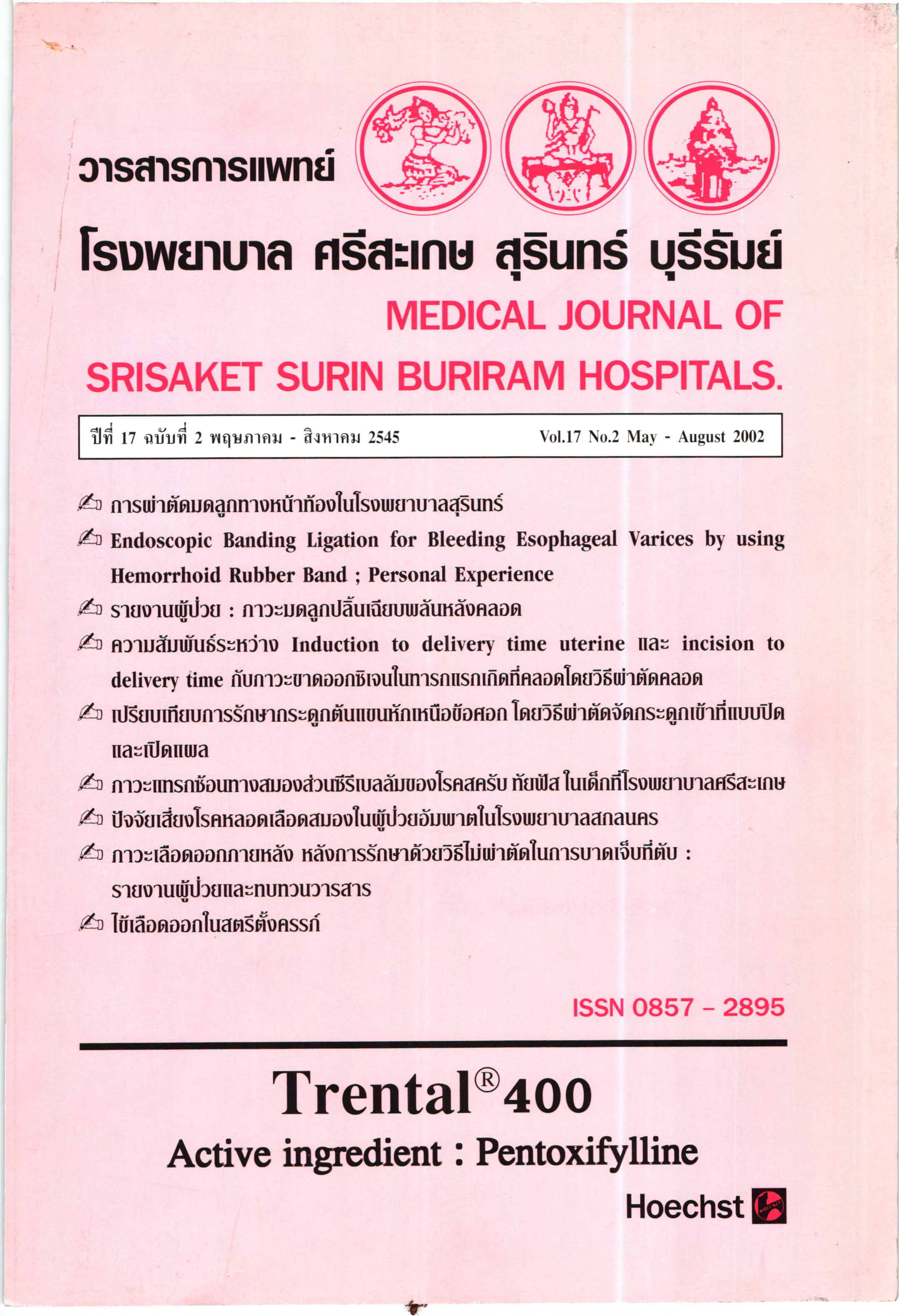ความสัมพันธ์ระหว่าง Induction to delivery time และ uterine incision to delivery time กับภาวะขาดออกซิเจนในทารกแรกเกิดที่คลอดโดยวิธีผ่าตัดคลอด
Main Article Content
บทคัดย่อ
วัตถุประสงค์: เพื่อศึกษาความสัมพันธ์ของ Introduction to delivery time และ Uterine incision to delivery time ต่อภาวะขาดออกซิเจนในทารกแรกเกิด
รูปแบบของการวิจัย: การศึกษาแบบสังเกตการณ์
สถานที่ศึกษา: ผู้ป่วยใน โรงพยาบาลบุรีรัมย์
วิธีการ: ศึกษาผู้ป่วยหญิงตั้งครรภ์ครบกำหนดผ่าตัดคลอดทางหน้าท้องด้วยสาเหตุจาก อุ้งเชิงกรานไม่เหมาะสมหรือแผลผ่าตัดคลอดในท้องก่อน ให้การระงับความรู้สึกแบบทั่วไป บันทึกระยะเวลา induction to delivery time และ uterine incision to delivery time พร้อมทั้งประเมินสภาพทารกแรกเกิดในนาทีที่ 1และ 5 โดยใช้ Apgar score วิเคราะห์ทางสถิติโดยใช้ Relative risk และ Stratified analysis
ผลการศึกษา: ทารกแรกเกิดที่เกิดภาวะขาดออกซิเจนในนาทีที่ 1 จำนวน 22 รายระยะ I.D. เฉลี่ย 10.35 นาที ระยะ U.D.เฉลี่ย 3.25 นาที สูงกว่าทารกปกติ จำนวน 204 ราย ที่มีระยะ I.D.เฉลี่ย 8.14 นาที และ U.D. เฉลี่ย 2.06 นาที โดยเมื่อระยะ I.D. นานกว่า 8 นาที จะทำให้ทารกเสี่ยงต่อการขาดออกซิเจนถึง 4.42 เท่า เช่นเดียวกับระยะ U.D. ที่นานกว่า 3 นาที จะทำให้ทารกเสี่ยงต่อการขาดออกซิเจนสูงกว่าถึง 3.61 เท่า
สรุป: ระยะ I.D. และระยะ U.D. ที่นานมากขึ้น ทำให้ทารกเสี่ยงต่อการขาดออกซิเจน ขณะแรกเกิดเพิ่มขึ้น แต่ไม่พบผลต่อทารกอย่างถาวร
Article Details
เอกสารอ้างอิง
2. Sentos, Alan C, Pederson, Wilda, Finster Mieczysla. Obstetric Anesthesia. In Paul GB, Burce FC, Robert K, eds : Clinical Anesthesia. 3 rd ed. Philadelphia : Lippinott - Raven, 1997 : 1010.
3. Hodges RJH, Bennett JR, Tunstall ME. General anesthesia for operative obstetrics : with special reference to the use of thiopentone and suxamethonium. Br J Anesth 1959;31:152.
4. Barter RH. Cesarean section : Past and present. Hosp. Pract 1967;2:50.
5. Teramo K. Fetal acid-base values during casearean section. Lancet 1968;2:1146.
6. Fothergill RJ, Roberstron A, Bond RA. Neonatal acidaemia related to procoastinatium at caesarean section. J Obstet Gynecol Br Common 1971;78:1010.
7. Datta S, Ostheimer GW, Weiss JB, Brown WU Jr, Alper MH. Neonatal effect of prolonged anesthetic Induction for cesarean section. Obstet Gynecol 1981 Sep;58(3):331-5.
8. Crawford JS, James FM, Crawley M . A further study of general anesthesia for caesarean section. Br J Anaesth 1967;48:661.
9. Shnider SM, Levinson G . Anesthesia for cesarean section In: Shinder SM,Levinson G, eds : Anesthesia for obstetrics. 3 eds. Baltimore: Williams & Wilkins, 1993:211-45.
10. World Health Organization. ICD-10 International Statistical Classification of Disease and related health Problem. 10th ed. Geneva : World Health Organization. 1992;94:777.
11. American Academy of Pediatrics, American College of Obstetricians and Gynecologists. Use and abuse of the Apgar score. Pediatrics 1996;98:141-2.
12. James FM III, Crawford JS, Hopkineson R .Comparison of general anesthesia and lumbar epidural analgesia for elective cesarean section. Anesth Analg 1977;56:228.
13. Zagorzycki Mt, Brinkmon CR. The effect of general and epidural anesthesia upon neonatal Apgar scores in repeat cesasean section. Surg Gynecol Obstet 1982;155(5):641.
14. Benson RC, Shubeck F, Clarke WM, Berendes H. Weiss W, Deutschbergen J. Fetal compromise during elective cesarean section. Am J Obstet Gynecol 1965;91:645-651.
15. Ong BY, Coten MM, Palahniuk RJ. Anesthesia for cesarean section : Effects on nenates. Anesth Analg 1989;68:270-275.
16. Fox BS, Smith JB, Namba Y, Johnson RC . Anesthesia for cesarean section : further study Am J Obsted Gynecol 1979;133:15-9.
17. Crawford JS, Janes FM 3rd Davies P, Crawley M : A further study of general anesthesia for cesarean section. Br J Anaesth 1976;48:661-7.


